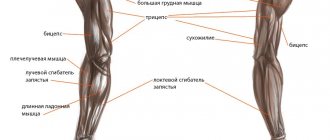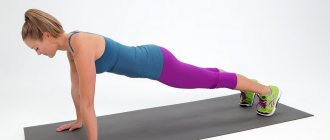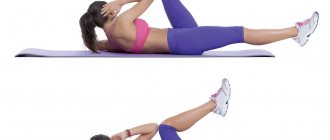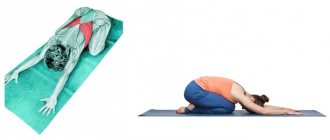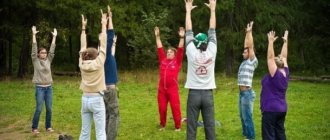During a normal pregnancy, physical activity is as necessary as adequate sleep or good nutrition. That is why expectant mothers are recommended to master special gymnastic complexes that will not only benefit their health, but also help prepare for childbirth.
During pregnancy and childbirth, intra-abdominal pressure increases sharply, and to contain it, you need strong, elastic muscles of the abdominal press and pelvic floor. Women who exercise during pregnancy are much less likely to experience swelling and stretch marks on the skin of the abdomen and thighs.
Regular exercises help develop proper breathing necessary during childbirth, prepare the cardiovascular system for increased stress, increase blood flow to the vessels of the uterus and placenta, which ensures a better supply of oxygen and nutrients to the fetus. Physical training reduces the risk of complications (bleeding, weakness of labor, etc.), helps to recover faster after childbirth. Finally, physical exercise is a powerful psychotherapeutic factor that helps avoid depression during pregnancy and after childbirth.
Physical training skills are also necessary during childbirth, since during the most critical period of childbirth - pushing, the muscles of the woman giving birth are actively involved. One of the skills necessary during childbirth, acquired by performing special exercises for pregnant women, is the ability to tense some muscle groups while completely relaxing others.
When does the risk outweigh the benefit?
Adequate physical activity is necessary not only for healthy pregnant women. Reasonable, dosed exercises are prescribed even to women with serious chronic diseases: diabetes, hypertension, pathology of the kidneys, heart, thyroid gland. However, there are a number of conditions in which any gymnastics is absolutely contraindicated.
These include:
- the presence of acute (for example, ARVI) or exacerbations of chronic (pyelonephritis, gastritis, cholecystitis) diseases;
- the threat of termination of pregnancy at any stage, as well as the presence of miscarriages at this stage of pregnancy in the past;
- bleeding from the genital tract, placenta previa or low-lying placenta;
- early toxicosis of pregnancy, accompanied by vomiting;
- gestosis is a disease of the second half of pregnancy, accompanied by increased blood pressure, edema and the appearance of protein in the urine;
- polyhydramnios.
In addition to established diagnoses, there are signs that, if they appear, you should immediately stop training, and if they appear during each session, then stop doing gymnastics altogether:
- pain in the lower abdomen, constant or cramping;
- increased uterine tone that does not go away immediately after finishing the exercise;
- the appearance of unusual vaginal discharge;
- dizziness, visual impairment;
- difficulty breathing, shortness of breath, pain in the heart area;
- increase in blood pressure more than 140/100 mm Hg. Art. or an increase in heart rate of more than 120 beats per minute during exercise (the heart rate should return to normal 5 minutes after the end of the exercise);
- violent movements of the fetus during training or a long absence of movements after its completion.
Before starting classes, you need to enlist the support of the gynecologist who is observing you.
Breathing exercises: basic exercises for any period
Breathing exercises can be performed at home at any stage of gestation. Doctors often prescribe it, even when other exercises are contraindicated. The sooner you start classes, the more benefits they will bring. This type of gymnastics teaches proper breathing, which helps make childbirth easier and saturates the body with oxygen, preventing fetal asphyxia.
Exercise #1:
- Lie on the floor on a gymnastics mat. Bend your legs at the knees and relax.
- Place one palm on the chest, the other on the abdominal muscles.
- Inhale deeply through your nose and exhale slowly. At the same time, do not move your chest. Breathe with the diaphragm, i.e. protruding and retracting the stomach.
- Do gymnastics for 7-10 minutes.
Exercise #2:
- Remain in a lying position, palms also placed on the stomach and chest, legs bent at the knees.
- Take a deep breath. Lift your shoulders and head off the floor without changing the position of your stomach.
- Change hands. Repeat the exercise.
- Perform 10 times.
Any training for pregnant women should be carried out with the permission of a doctor, in good health and without fanaticism.
Exercise #3:
- Sit in the “Turkish” position (crossed legs), lower your arms along your body.
- Bend your elbows and lift them so that your palms are at chest level. Inhale at the same time. The abdomen and chest remain motionless.
- Slowly extend your arms to the starting position while exhaling.
It is recommended to perform gymnastics once a day for 30 minutes. Can be done both before and after the main exercises.
The problem of choosing activities for pregnant women
The approach to classes should be individual and primarily depend on what level of training you had before pregnancy.
For trained women, the level of physical activity immediately after establishing the fact of pregnancy should be reduced by a third. There are sports that are extremely undesirable to engage in during pregnancy. First of all, these are traumatic sports, all game sports, jumping and vibration, lifting weights over 3 kg and less above the shoulder girdle are also contraindicated. The optimal sports are walking, swimming, and cross-country skiing.
In addition to these classic sports, there are also special techniques adapted for pregnant women.
Gymnastics on a fitball - a large gymnastic ball - trains the sense of balance, coordination of movements, and allows you to train those muscle groups that are not involved in regular exercises. At the same time, the muscles not involved in the exercises remain relaxed, which avoids overwork.
Pilates is a set of exercises for the whole body that develops flexibility and mobility, named after the developer of this system, Joseph Pilates. Exercises strengthen the deep muscles that fix the normal position of the spine and internal organs. These muscles include the paravertebral muscles, abdominal muscles, pelvic floor, and lower back. Thanks to constant training, a woman manages to avoid back pain associated with a shift in the center of gravity of the body with increasing pregnancy. In addition, Pilates helps to increase the extensibility of the perineal tissues, “opening” of the hip joints - relaxing the ligaments, which allows the joint to work in greater amplitude, as well as teaches isolated tension of the abdominal muscles, i.e. skills needed during childbirth.
Yoga. Yoga classes are aimed at developing posture, strengthening and stretching the joint and ligamentous apparatus, as well as restoring psycho-emotional balance and strengthening the nervous system. Yoga improves blood circulation, helps cope with fatigue, swelling, headaches and constipation, and is the basis of any breathing exercises and relaxation techniques. Yoga asanas (special poses) help stretch the spine, relax and stretch the pelvic muscles, strengthen the abdominal muscles, “open” the hip joints, etc.
If you did not exercise regularly before pregnancy (2-3 times a week), then your choice should be special classes for pregnant women: physical therapy, recreational swimming, breathing and relaxation training. The ideal option is individual training with an instructor. Special groups for expectant mothers are more accessible. It is good if the composition of such a group is constant and homogeneous in terms of gestational age.
The approach to classes should be individual and primarily depend on what level of training you had before pregnancy.
During exercise, it is necessary to avoid overheating and dehydration. The training room should be well ventilated, but without drafts, the optimal temperature is about 20ºC. You should avoid training in stuffy and humid areas, as well as dressing too warmly. Proper breathing is of great importance: breathe slowly through your nose, inhale during the tense stage of the exercise, exhale during relaxation. Classes should be carried out two hours after and one hour before meals.
Exercises for pregnant women: benefits
Not all pregnant women do exercises. Some are even afraid to walk so as not to harm the unborn baby. However, the benefits of physical activity are enormous. Exercise for pregnant women is useful due to the following factors:
- Exercise helps keep muscles toned, reducing the risk of stretch marks and extra pounds after childbirth.
- Breathing training is important to help ease childbirth.
- Regular warm-up lifts a pregnant woman's mood, charges her with energy and soy.
- Blood circulation improves, which means the fetus is better supplied with nutrients.
- Exercise helps prevent a number of problems characteristic of pregnancy, including swelling, varicose veins, heartburn, constipation, pain in the back, lower back, and legs.
- Physical activity helps improve coordination.
When can you exercise during pregnancy?
In the first trimester of pregnancy (up to 12 weeks), unprepared expectant mothers who did not exercise at all or only occasionally exercised before pregnancy should focus on walking, breathing exercises, relaxation, and exercises to strengthen the muscles of the perineum and arch of the foot. The arch of the foot experiences significant stress during late pregnancy, so it is important to prepare it now. At the same time, on the days corresponding to menstruation according to the individual calendar, it is better to avoid any physical activity. At this stage, it is important to exclude exercises on the abdominal muscles.
Physical fitness skills are also necessary during childbirth.
You need to start training gradually, from 10-15 minutes, and your condition should be described by the term “comfortable” - no “I can’t do” exercises. If you have not played sports before, then your first lesson will consist only of a warm-up and a final part. Then gradually add exercises from the main part.
Exercise for the third trimester
Exercising for pregnant women in the 3rd trimester is complicated by those who already have an impressively sized tummy that prevents them from performing most exercises. A fitball can help you, with which you can perform very effective exercises to prepare for childbirth.
Exercise with dumbbells for abdominal and back muscles
You need to sit on a fitball, take dumbbells weighing up to 1 kg in your hands, and lower them along your body. Bend your elbows, lifting the dumbbells to armpit level, then slowly lower them to the starting position, without tilting your body. Then bend your elbows, lifting the dumbbells to your shoulders and slowly lowering them. Alternate movements, watching your breathing.
Exercise to strengthen the muscles of the perineum and thighs
Lie on the floor, put one leg on the fitball. Now try to roll the ball, moving your leg to the side and returning it to its original position. You can also move the ball by bending your knee. Repeat the exercise 3-4 times. The same thing is repeated for the second leg.
Chest exercise
Take the fitball in your hands and hold it, stretching them out in front of you. Now try to slowly squeeze it with your palms, and then slowly relax your hands. It is important to ensure that your stomach does not become tense during this exercise. Repeat the exercise 5-10 times.
Exercising for pregnant women in the 3rd trimester at home using a fitball becomes effective and safe. Don't forget to use a bandage to support your tummy. Water aerobics exercises designed specifically for expectant mothers will also be useful. Watch the video of exercises for pregnant women in the 3rd trimester to understand more about its implementation.
A set of exercises in the first trimester of pregnancy
Here is an approximate set of exercises for the first trimester of pregnancy, which is also suitable for unprepared mothers.
Warm-up
The warm-up exercises are quite simple. They are familiar to everyone from the morning exercise complex. Starting position: standing, feet shoulder-width apart.
- As you inhale, shoulders up, as you exhale, shoulders down.
- As you inhale, move your shoulders back, as you exhale, move them forward.
- Circular movements of the shoulders forward and backward.
- Tilt the head to the right - left, forward - back.
- Slow circular movements of the head.
Advertising
Main part
- Slow, calm walking (1-2 minutes).
- Walking while moving your arms back (as you inhale), bent at the elbows, and bringing them together in front of your chest (as you exhale), also bent at the elbows (1-2 minutes).
- Starting position - standing (hands on the back of your head, elbows forward), spread your elbows (inhale). Take the starting position (exhale). Repeat 6-8 times.
- Starting position: sitting on the floor (hands on the waist, feet shoulder-width apart). Raise your arms to the sides while turning your torso (inhale). Take the starting position (exhale), the same - in the other direction (3-5 times).
- Sitting (legs stretched forward, hands at the back resting on the floor), bend your knees (exhale). Spread your knees, bringing your soles together (inhale). Connect your knees (exhale). Take the starting position (inhale). Repeat 6-8 times.
- Sitting, lean on your arms, extended to the sides and slightly back. Place your left foot on your right. Circular movement of the left foot to the right and left 3-4 times. Take the starting position. The same with the right foot. Repeat with each leg 5 times.
- Lying on your side (hand under your cheek, legs extended), bend your legs and pull your knees towards your stomach (exhale). Take the starting position (inhale). The same thing on the other side. Repeat 3-4 times.
- Slow, calm walking.
The final part is relaxation
- Lie on your back. Bend your knees and place your feet on the floor, relax your buttock muscles. Without straining, slightly stretch the back of your neck. In this case, the chin will move closer to the chest, but the throat should remain relaxed and the head should lie on the floor. Close your eyes. As you exhale, relax your shoulders and gently press them to the floor. Relaxed arms are slightly spread to the sides, palms up, fingers bent freely.
- Lower your legs one by one to the floor, extending them from hip to heel. Spread your toes slightly to the sides. At the end of each exhalation, hold your breath for a second and lower (as if plunging into the floor) your back, pelvis, arms, and back of your head - this will be a natural continuation of the breathing movement. Try to completely exhale all remaining air from your lungs, and then inhalation will follow naturally.
- Continue to breathe evenly. Focus on your face. The facial muscles should relax. The corners of the mouth are relaxed, the eyes are closed (do not move your eyes).
Important Muscles
At any stage of pregnancy, it is necessary to exercise tensing and relaxing the pelvic floor muscles several times a day: straining them while inhaling and relaxing while exhaling. This exercise can be done while performing any daily activities, and the acquired skill will help you control your condition during childbirth (relax the perineum in time at the request of the midwife at the birth of the fetal head, which will facilitate the movement of the fetus along the birth canal and help avoid ruptures).
Changes in the body during pregnancy
In the very early stages of pregnancy, physiological changes begin in the body at different levels. First of all, hormonal, the active production of hormones promotes stretching of the ligaments of the uterus, pelvis, and promotes changes in the entire skeleton.
In the body of pregnant women, the “main” organ is the uterus. During active growth, it displaces organs and the spinal column. In response to this, the body aligns itself around the uterus, creating conditions for the development of the fetus.
The most visible changes occur in the second and third trimester: • Figure of a chess knight Active growth of the fetus contributes to a deepening of the lumbar lordosis, and an increase in thoracic kyphosis, the head and sacrum lean forward. Such changes are caused by a change in the center of gravity to be able to maintain a vertical position. • Load on the muscles To support the growing fetus and uterus, the muscles of the back, diaphragm and abdominal wall experience enormous stress. An additional aggravating factor is the displacement of internal organs, and all this causes overstretching of the muscles of the anterior abdominal wall. • Opening of the pelvis In a pregnant woman, the pelvis is described as a flower, which is necessary for the fetus to pass through the birth canal. But if the posture is poor, there is scoliosis, or asymmetry of the pelvic bones, then the opening occurs unevenly. What's the result? Chronic pain and discomfort. • Symphysis The pubic bones are connected to each other by cartilaginous tissue - the symphysis. Normally, its width is 5 mm; during pregnancy, due to the production of relaxin, it expands. But if it is too strong, problems are formed, namely symphysitis, which is characterized by severe pain, changes in gait, etc. • Pelvic floor muscles This is a muscular-fascial septum and during gestation they experience a large load, and then overstretch during childbirth. This can cause pelvic floor muscle incompetence.
By the way, one of the main tasks of the recovery period is the prevention of pelvic floor dysfunction.
A set of physical exercises in the 2nd trimester of pregnancy
In the second trimester of pregnancy (from the 13th to the 32nd week), the pregnant woman’s condition stabilizes; this is the safest period for physical education and sports. The warm-up and final part complexes are the same for the entire pregnancy, only the content of the main part of the exercises changes. During this period, the complex of classes includes exercises to strengthen the muscles of the back, abs, and legs, increasing the mobility of the joints. Due to the increased load on the spine, no more than one third of the exercises are performed in a standing position.
Main part
- Slow, calm walking (2-4 minutes).
- While standing, raise your right hand slightly up, your left hand to the side; At the same time, take your left leg back and lift it without bending the knee (inhale). Take the starting position (exhale). Do the same with the other leg, changing the position of the hands. Repeat 3-4 times.
- From a standing position, squat down, arms down and then back (exhale). Take the starting position (inhale). Repeat 4-6 times.
- Starting position - standing, hands connected at the back. Lower your arms down, bend in the thoracic part of the spine, simultaneously pulling in your buttocks (inhale). Take the starting position (exhale). Repeat 4-6 times.
- Sitting on the floor (hands on the belt, legs wide apart), touch the toe of the outstretched left leg with your right hand (exhale). Take the starting position (inhale). Repeat 4-6 times, alternating arms and legs.
- On all fours, bend your spine in the lumbar region (exhale). Curve your spine upward - “cat back” (inhale). Repeat 4-6 times.
- Kneeling, sit on your heels, resting your hands on the floor (exhale). Place your hands behind your back, rest on the floor, raise your pelvis (inhale). Take the starting position. Repeat 3-4 times.
- Lying on your back (arms along your body, legs bent at the knees), raise and spread your legs (inhale). Take the starting position (exhale). Repeat 3-4 times.
- Lying on your back (legs bent at the knees and pulled towards the stomach), perform the “bicycle” 6-10 times. Do not hold your breath.
- Slow, calm walking (2-4 minutes).
Advertising
Rules of gymnastics for pregnant women
You can find a lot of information about how a pregnant woman should behave: rest more, take care of yourself like a valuable vase of the Jin Dynasty, eat for two, etc. You can also find recommendations about exercises.
Classes should only be carried out under the supervision of a movement specialist. This is the only way to ensure their safety and positive effect.
The specialists of the Quality of Life clinic strongly advise against mastering new types of physical activity. If a woman was a jogger before pregnancy, you can naturally continue jogging at a lower intensity if there are no medical contraindications, but you should not do jumping. Moreover, there are exercises and sports that are contraindicated: • those that increase intra-abdominal pressure, for example, squats, crunches, etc.; • performed lying on your back; • abdominal training, weight lifting; • any sports associated with a high risk of falls and injuries; • you should avoid exercises for pregnant women that strain the hip flexor muscles.
There are 4 general recommendations: high-intensity training, sudden movements and jerks are prohibited, and exercise with caution with elements of stretching and weight lifting.
When performing exercises, the main condition is a positive attitude and good health. The friendly atmosphere at the Quality of Life clinic was created specifically for patients and their success.
What physical exercises should you do in the 3rd trimester of pregnancy?
In the last months before childbirth, shortness of breath often occurs due to the displacement of the diaphragm, so exercises that deepen breathing and reduce congestion in the lower part of the body, in the legs, are especially useful. They are mostly performed lying down or sitting, slowly, smoothly and measuredly. Exercises should be performed in a volume in which the load does not cause discomfort.
Main part
- Slow, calm walking (2-4 minutes).
- Starting position: standing, hands on the back of your head, elbows forward. Spread your elbows (inhale). Take the starting position (exhale). Repeat 6-8 times.
- Starting position - sitting (leaning on your hands behind your back), the left leg is extended and lies on the right. Circular movement of the left foot in different directions 3-4 times. The same with the right foot. Breathing is voluntary. Repeat 2-3 times.
- Starting position: sitting, resting your hands behind your back. Turn your torso and move your right hand to your left (exhale). Take the starting position (inhale). The same - in the other direction. Repeat 3-4 times.
- Standing on all fours, bend your spine in the lumbar region (exhale). Arch your spine upward—“cat back”—(inhale). Repeat 4-6 times.
- Standing on all fours, sit on your heels (exhale). Take the starting position (inhale). Repeat 2-3 times.
- Starting position - lying on your side (the arm located below is extended forward and bent at the elbow, the other is along the body). Raise your upper body, resting on your elbow (exhale). Take the starting position (inhale). Repeat 2-4 times on each side.
- Starting position - lying on your side (hand under your cheek, the other along the body). Bend your legs at the knee and hip joints (exhale). Take the starting position (inhale). Repeat 3-4 times on each side.
- While standing, alternately relax the muscles of the neck, torso, and arms, turning the torso to the right and left sides. Breathing is deep and voluntary. Repeat 3 times.
- Slow, calm walking (2-4 minutes).
What exercises can pregnant women do?
If you exercised regularly before pregnancy, you can probably continue exercising during pregnancy. It is important not to overdo it, be careful and choose the right exercises that cannot cause harm.
Surely many girls have heard from relatives, friends or even doctors that bearing a child should be accompanied by absolute peace, minimal activity, etc. But a recent study of more than 2,000 women found that moderate-intensity aerobic and strength/toning exercise done 3 to 4 days a week throughout pregnancy was not associated with the risk of preterm birth or low-grade newborns. body weight. This applies to women with normal weight and singleton uncomplicated pregnancy. Despite doctors' recommendations to start or maintain an exercise program during pregnancy, only about 40% of patients exercise.
During all three trimesters, it is recommended to give preference to cardiovascular exercises, such as:
- fast walk
- swimming
- exercise bike
- prenatal yoga
- low impact aerobics led by a certified aerobics instructor
- special exercises to prepare for childbirth
These exercises are safe, have virtually no risk of injury, and benefit the entire body.
Fast walk
If your level of physical activity before pregnancy was low, you can start by walking around the house and surrounding area.
This class has several benefits - it's free, requires no equipment, and provides a cardiovascular workout with relatively little impact on the knees and ankles.
Swimming
Swimming, water walking, and water aerobics allow you to move without putting stress on your joints, can relieve swelling in your legs and feet, relieve stress, and help your baby get into the right position for birth. Just avoid backstroke during late pregnancy, as this can put pressure on major blood vessels in the abdomen, and avoid diving and jumping. Also avoid warm pools, steam rooms, hot tubs and saunas to minimize the risk of overheating.
Exercise bike exercises
Riding an exercise bike is safe for most women during pregnancy, including those who are new to the sport.
Cycling helps raise your heart rate, minimizes stress on your joints and pelvis, fights excess weight gain and, due to its stability, reduces the risk of falling or other injuries.
Yoga
Prenatal yoga strengthens muscles, stimulates blood circulation, increases flexibility, and relieves back pain. In the long term, this helps make labor shorter and more comfortable. According to one study, practicing yoga can also help manage stress.
It is worth avoiding asanas that can lead to imbalance, are performed on the stomach or involve prolonged stay on the back.
Contraindications
In addition to relative contraindications, that is, those that force you to temporarily stop training, there are also absolute ones. These include:
- toxicosis in the 2nd and 3rd trimester (if it does not go away after the first three months, it becomes a pathological condition called gestosis);
- previous pregnancy ended in miscarriage;
- the uterus is in good shape;
- risk of miscarriage;
- the placental membrane is located too low;
- spotting, abdominal pain;
- varicose veins, hemorrhoids (you cannot do leg exercises);
- increased or decreased intravenous pressure, anemia (before starting training, you need permission from the obstetrician-gynecologist managing the pregnancy).
If you do not take contraindications into account, you can provoke adverse consequences both for your own health and for the baby. In any case, even if there are no listed pathological conditions, you should consult a doctor before starting training. At first, it is better to work out in the gym under the guidance of a trainer. Once the movements are perfected, you can start training at home.
In conclusion, I would like to give some useful recommendations for women in delicate situations. When training, it is important to monitor your water balance. To avoid dehydration, drink at least 2 liters of filtered or still mineral water. It is recommended to do exercises at the same time, no matter in the morning or evening. Before training, the bladder should be empty. You can eat 1.5-2 hours before classes. For better oxygen supply to the lungs, pre-ventilate the room. If possible, it is better to train outside, for example, on a terrace. Yoga classes for pregnant women will also be useful.
As it became clear, if there are no contraindications for physical activity, exercises for pregnant women must be done. This will help strengthen your own health, successfully resolve the birth process, and give birth to a strong baby. The main thing during training is to monitor your well-being; physical activity should be moderate, bring pleasure, and not exhaust and deplete the body.
Exercises to prepare for pregnancy
Physical exercise is aimed at achieving four main goals:
- Prevention of flat feet.
- Strengthening the abdominal muscles.
- Training the muscles and ligaments of the pelvic floor.
- Strengthening the back muscles.
Experts recommend starting with light loads. Walk on the floor barefoot for two minutes, then walk on your toes, on the inside and outside of your feet (one minute, not each exercise). Alternate these types of walking for six minutes. This part of the workout should be completed with normal walking.


